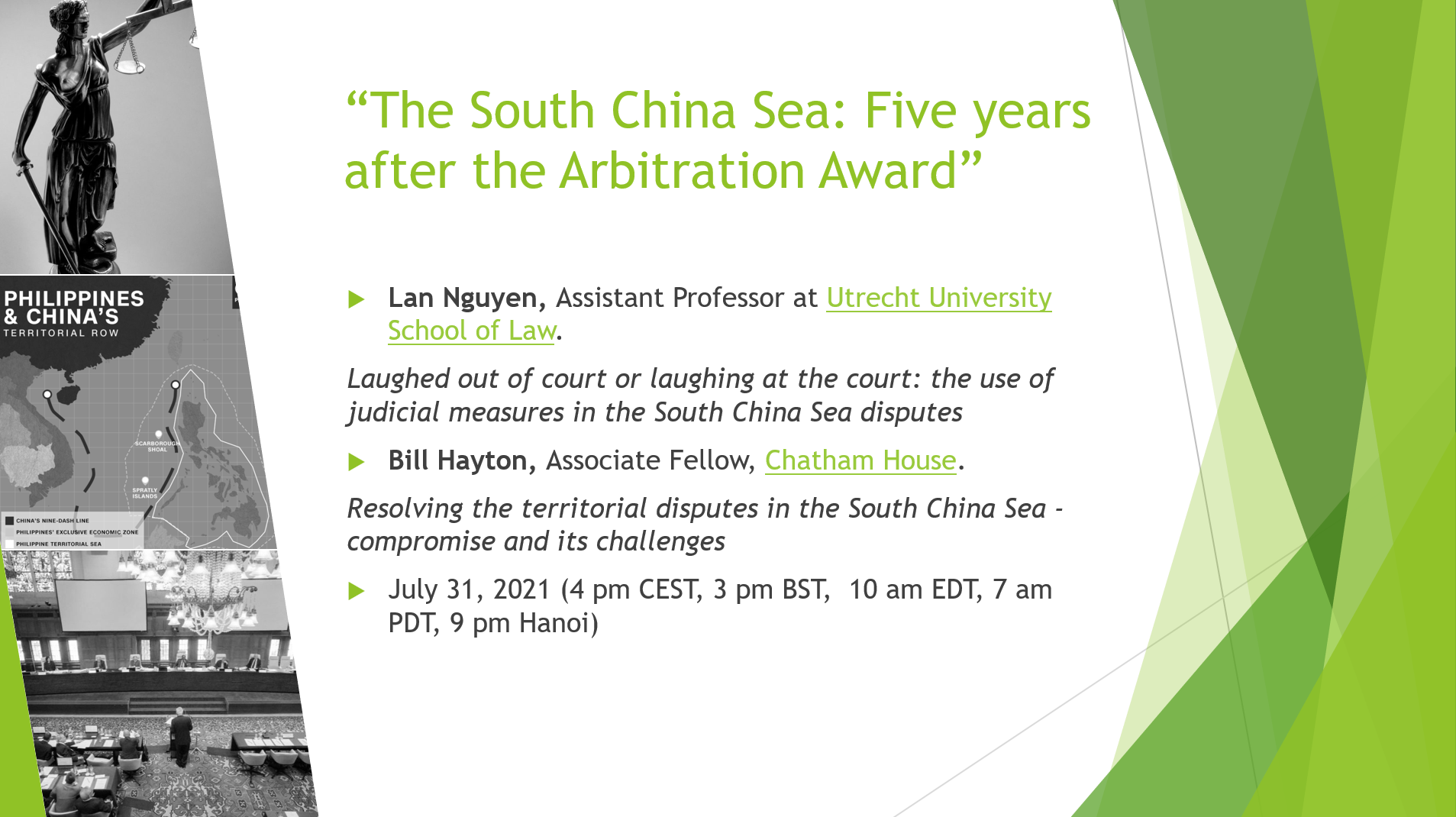International Online Conference
“The South China Sea: Five years after the Arbitration Award”
Hosted by US-Vietnam Research Center, Global Institute, University of Oregon
July 31, 2021 (4 pm CEST, 3 pm BST, 10 am EDT, 7 am PDT, 9 pm Hanoi)
See the conference video here.
Introduction
The South China Sea is an important gateway connecting the Indian Ocean with the Pacific Ocean. A peaceful environment in these waters is crucial for countries in South East Asia. However, ASEAN faces the challenge from China’s claim of over 80% of the South China Sea.
In 2013, the Philippines officially filed a lawsuit against China in the Permanent Court of Arbitration under Annex VII of UNCLOS. The Arbitral Tribunal issued the Award on July 12, 2016, denying the Chinese U-shaped line on the South China Sea.
July 2021 marks the 5th anniversary of the Permanent Court of Arbitration Award defending the Philippines’ lawsuit against China over the South China Sea issue.
Over the past five years, the claimant states around the South China Sea have made many significant strategic changes.
Positive moves are going on in the South China Sea. From 2018, China and ASEAN have again launched the Code of Conduct negotiations, which were delayed many years ago. They hope to sign the COC in 2021 if there are no obstacles.
However, there are also negative developments in the South China Sea.
China has still conducted military exercises in the South China Sea, threatened and prevented other countries from exploiting their EEZ. In the summer of 2019, China did a long-term campaign intruding into the EEZ and continental shelf of Vietnam, Philippines, and Malaysia. Malaysia reacted by submitting a new claim to the “extended the continental shelf” in December 2019. Malaysian action and the Chinese reaction provoked a war of diplomatic notes among countries worldwide regarding the South China Sea in 2020. At this time, July 2021, China has intruded Malaysian EEZ and continental shelf.
Earlier this year, China passed the Coast Guard Law, which allows the Chinese Coast Guard to fire on fishing boats of other countries with the U-shaped line in the South China Sea. In early March, China deployed 220 fishing boats around the Whitsun Reef area within the EEZ of the Philippines.
China’s actions are not merely dominating the entire South China Sea. Does the way China interprets UNCLOS and its claims in the South China Sea show that China wants to change the world order based on the rules established since 1945 until now?
We want to discuss what happened in the last five years, predict what may happen in the near future, and the reasonable choices of claimant states to build peace and justice in the South China Sea. What will/should great powers such as the US do to maintain an international rules-based order in the South China Sea? What will the Biden administration do in the South China Sea to contain China? Where does China’s ambition in the South China Sea come from? What should Southeast Asia do to counter China’s threat in the South China Sea? What is the value of the Award for international law? Should Vietnam sue China as the Philippines did?
Resource Speakers
Lan Nguyen, Assistant Professor at Utrecht University School of Law.
Laughed out of court or laughing at the court: the use of judicial measures in the South China Sea disputes
Bill Hayton, Associate Fellow, Chatham House.
Resolving the territorial disputes in the South China Sea – compromise and its challenges
Chair
Nguyen Luong Hai Khoi, Managing Editor, US-Vietnam Review, University of Oregon

 Politics & Economy4 years ago
Politics & Economy4 years ago
 Politics & Economy2 years ago
Politics & Economy2 years ago
 After 19751 year ago
After 19751 year ago
 ARCHIVES5 years ago
ARCHIVES5 years ago
 Society & Culture5 years ago
Society & Culture5 years ago
 Politics & Economy4 years ago
Politics & Economy4 years ago
 Politics & Economy5 years ago
Politics & Economy5 years ago
 Politics & Economy4 years ago
Politics & Economy4 years ago







